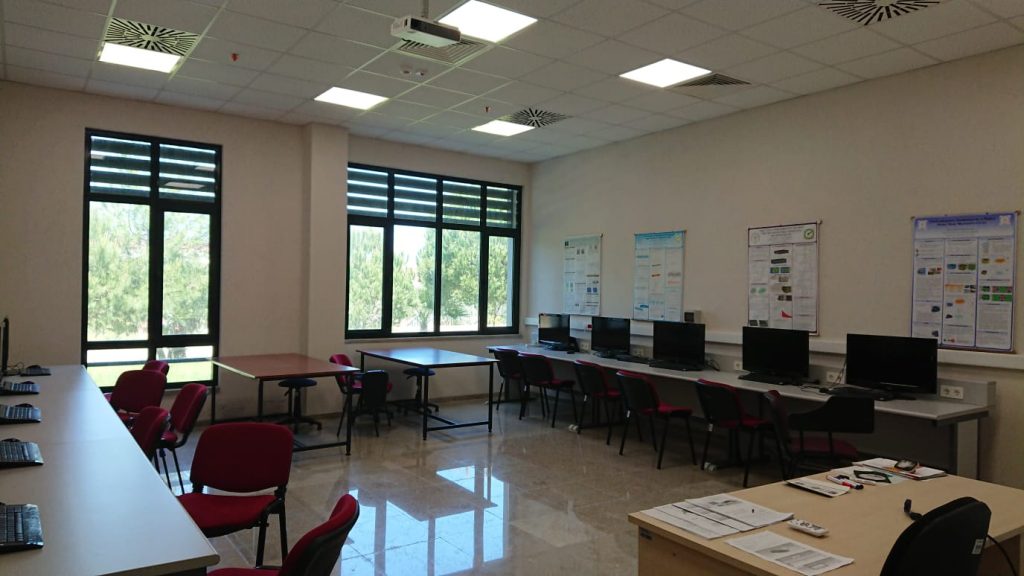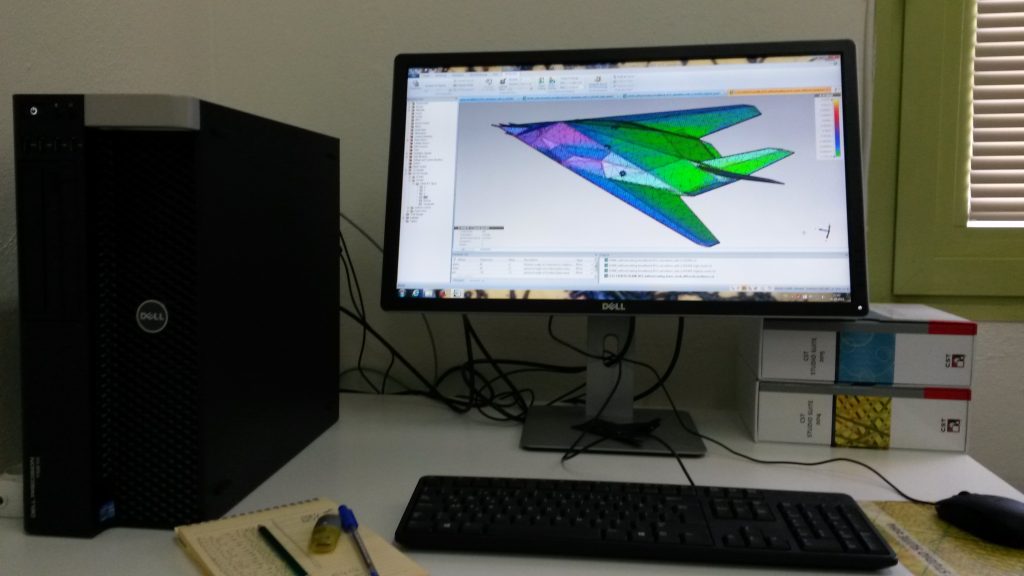Computational Electromagnetics Laboratory




Academics
- Asst. Prof. Dr. Fatih Yaman
- Res. Asst. H. Önder Yılmaz
- Res. Asst. Anıl Karatay
- Res. Asst. Ceren Özkal
Main Research Topics
- Finite Difference Time Domain Method, Finite Element Method, Boundary Integral Equation Methods, Particle in Cell Algorithms
- Microwave Structure Designs for Particle Accelerators
- Impedance and Wake Field Calculations
- Electron Cloud Calculations
- Numerical Solutions of Inverse Scattering Problems
Projects
- Compact Proton Accelerator in UHF band (TUBITAK – 1001, 2019- on going 3 years) led by Boğaziçi University Kandilli Detector, Accelerator and Instrumentation Laboratory
- Experimental Investigations of Electromagnetic Effects for Mechanical Defects Occur in the Production of Particle Accelerator Cavities (2019-2020)
- RF Circulator and RF Transmission Line Simulation and Production (TUBITAK-1005) led by Boğaziçi University Kandilli Detector, Accelerator and Instrumentation Laboratory (2017-2019)
- Impedance Calculations for Particle Accelerators (2015-2016)
- 1-5 MeV Proton Accelerator with RF Cavity Production led by Turkish Atomic Energy Authority (TAEK)
Collaborations
- CERN FCC-ee Optics-Design Group
- Boğaziçi University Kandilli Detector, Accelerator and Instrumentation Laboratory(KAHVELab)
- Turkish Accelerator & Radiation Laboratory (TARLA)
- Turkish Atomic Energy Authority (TAEK)
Publications
- Journal Articles
- Conference Publications
- Yaman, Fatih “Quantification of resistive wall instability for particle accelerator machines”, Turkish Journal of Electrical Engineering & Computer Sciences 27 (6), 4756-4767, 2019
- Yaman, Fatih “Numerical investigations of resistive wall wake potentials”, Electronics Letters, Volume: 56 , Issue: 3, 129 - 132 , 2020
- Yılmaz, H. Önder; Yaman, Fatih “Meta-material Antenna Designs for a 5.8 GHz Doppler Radar”, IEEE Transactions on Instrumentation and Measurement, Volume: 69 , Issue: 4, 1775 – 1782, April 2020
- Karatay, Anıl; Yaman, Fatih “Electromagnetic Simulations of Mechanical Imperfections for Accelerator Cavities”, IEEE Transactions on Nuclear Science 66 (11), 2295-2304, 2019
- Karatay, Anıl; Orcan, Durmuş; Özkal, Ceren; Yaman, Fatih “Implementation and experimental verifications of microstrip antennas for angular scanning of a Doppler radar”, AEU-International Journal of Electronics and Communications 101, 76-84, 2019
- Yaman, F.; Yakhno, V.G.; Özdemir, C.; Yu, T.Y.; Potthast, R. “Recent theory and applications on inverse problems 2014, Mathematical Problems in Engineering, 2015
- Yaman, F.; Weiland, T. “Inhomogeneity reconstructions in tendon ducts via boundary integral equations”, NDT & E International 68, 66-72, 2014
- Yaman, Fatih “A Numerical Investigation for the Electron Cloud Build-Up Mechanism” In proceedings International Science, Mathematics and Engineering Sciences Congress, 2019
- Karatay, Anıl; Yaman, Fatih “Fully 3D Printed Bead-Pull Measurement of an Elliptical Cavity”, TURKISH PHYSICAL SOCIETY 35th INTERNATIONAL PHYSICS CONGRESS, 2019
- Özkal, Ceren; Yaman, Fatih “Investigations for Increasing the Accuracy of Dielectric Constant Measurements”, TURKISH PHYSICALSOCIETY 35th INTERNATIONAL PHYSICS CONGRESS, 2019
- Ogur, Salim; K. Oide; Y. Papaphilippou; L. Rinolfi; F. Zimmermann; A. Barnyakov; A. Levichev; P. Martyshkin; D. Nikiforov; E.V. Ozcan; Yaman, Fatih; K. Furukawa; N. Iida; T. Kamitani; F. Miyahara; I. Chaikovska; R. Chehab; SM. Polozov MEPhI “Linac and Damping Ring Designs for the FCC-ee”, 10th Int. Partile Accelerator Conf.(IPAC'19), Melbourne, Australia, 19-24 May 2019
- Yılmaz, H. Önder; Yaman, Fatih “Reconstruction of Medium Parameters for Metamaterial Antennas via Retrieval Method”, in book of abstract of Turkısh Physıcalsocıety 35th Internatıonal Physıcs Congress , 2019
- Karatay, Anıl; Yaman, Fatih “Fully 3D Printed Bead-Pull Measurement of an Elliptical Cavity”, Book Of Full Text Proceedıngs Turkısh Physıcal Socıety 35th Internatıonal Physıcs Congress (Tps35) TPS35, Vol.01, No.01, pp.42-49.
- Özkal, Ceren; Yaman, Fatih “Investigations for Increasing the Accuracy of Dielectric Constant Measurements”, , Book Of Full Text Proceedıngs Turkısh Physıcal Socıety 35th Internatıonal Physıcs Congress (TPS35) TPS35, Vol.01, No.01, pp.74-81
- Yılmaz, H. Önder; Yaman, Fatih “Meta-material antenna design for 5.8 GHz”, Doppler radar,” in Proc. 34th Int. Phys. Congr. Turkish Phys. Soc., 2018, p. 432.
- Özkal, Ceren; Yaman, Fatih “The Cavity Perturbation Method for the Dielectric Constants Measurements”, in Proc. 34th Int. Phys. Congr. Turkish Phys. Soc., 2018
- Karatay, Anıl; Yaman, Fatih “Electromagnetic Simulations of Mechanical Imperfections for Elliptical Cavities”, in Proc. 34th Int. Phys. Congr. Turkish Phys. Soc., 2018
- Cetinkaya, Hakan; Çağlar, Aslıhan; Çiçek, Cihan; Özbey, Aydın; Sunar, Ezgi; Türemen, Görkem; Yıldız, Hüseyin; Yüncü, Alperen; Özcan, Erkcan; Ünel, Gökhan; Yaman, Fatih “KAHVE Laboratory RF circulator and transmission line Project”, AIP Conference Proceedings 1935 (1), 070002, 2018
- Turemen,Gorkem; Yasatekin, B.; Ogur, S.; Yildiz, V.; Mete, O.; Oz, S.; Ozbey, A.; Yildiz, H.; Yaman, F.; Akgun, Y.; Alacakir, A.; Bolukdemir, S.; Bozbey, A.; Sahin, A.; Unel, G.; Erhan, S.;“Current Status of The Sanaem Rfq Accelerator Beamline” In proceedings 2015 International Particle Accelerator Conference, pp. 3952-3955, Richmond, USA.
Thesis
Author: Hikmet Bursalı
Year: 2018
Supervisor: Fatih Yaman , Nuria Catalan Lasheras
Type: Master’s Thesis
Abstract: The Compact Linear Collider (CLIC) Project is 50 km long e−, e+ linear collider planned to be built in three stages with 3 TeV center-of-mass energy at its last stage. The CLIC accelerator includes around 140000 accelerating structures. The cost optimisation process is ongoing before the production stage. In order to obtain the CLIC design requirements, the accelerating structures are machined out of OFE copper and ultra precision turning and milling with single diamond tool. The required precision on the order of the micron makes the final product relatively expensive. The assembly of these copper parts is done by electron beam welding of two halves or diffusion bonding of disc stacks. In this thesis we investigate the potential geometrical correlation between the imperfection of the accelerating structure discs inner radii and their individual frequency deviations before and after bonding. Following the results of this work, the tolerance study of the machining and bonding effects will be understood and manufacturing process will be optimised for cost saving.
Author: Hasan Önder Yılmaz
Year: 2018
Supervisor: Fatih Yaman
Type: Master’s Thesis
Abstract: This thesis presents mainly simulation and measurement results of metamaterial based transmitter and receiver antennas for a Doppler radar system operating at 5.8 GHz and indoor, outdoor and through-wall performances of the Doppler radar system after the integration of field and the realized transmitter and receiver antennas. Firstly, the antennas are modeled via 3D electromagnetic simulation program CST:Microwave Studio and related parameters are calculated. Afterwards, in order to observe antenna performances, radiation pattern and gain characteristics of realized antennas are measured in laboratory environment including anechoic chamber. Another essential objective of this thesis is to examine and analyze applicability and effectiveness of the metamaterial based antennas for a 5.8 GHz Doppler radar system. For this reason, a double negative index metamaterial structure is integrated to a patch antenna for the transmitter. For the receiver antenna, a near-zero index medium is designed to locate over patch antenna. Accordingly, significant improvements in size and bandwidth for the transmitter and in gain and directivity for the receiver in addition to improvement of its psychical size are obtained. It is shown that return loss, radiation pattern and gain measurement results of the designed antennas agree well with the simulations for a desired frequency band. According to the experimental data, the realized transmitter antenna has a higher directivity value as compared to the simulated one, therefore it radiates most of the power into narrower area. Additionally, the measured one has a wider bandwidth. The measurement results of receiver antenna are consistent with simulation in terms of bandwidth, return-loss, radiation pattern of horizontal direction and gain value. The last part of the thesis is devoted to expressing the application of the designed antennas to the low-power, short-range Doppler radar system, which is designed to detect the speed of the human or moving target in the indoor/outdoor environment or behind the wall. Improvements on the performance of the radar system integrated with metamaterial antennas are discussed and performances results are commented.
Author: Aslıhan Çağlar
Year: 2019
Supervisor: Fatih Yaman
Type: Master’s Thesis
Abstract: In recent years, usage of high power in modern technologies operating at microwave frequency range has been varying in research topics such as radar, plasma science, satellite communications and particle physics. Therefore, transmission of high power from a power generator to a specific target without loss is a key point of these research fields. In accordance with this purpose, a project has been started at the Kandilli Detector, Accelerator and Instrumentation (KAHVE) Laboratory of Boğaziçi University in Turkey which name is Design, Simulation and Production of an RF Circulator and Transmission Line. The aim of the project is to build a high power RF transmission line and circulator operating at 800 MHz frequency. In order to perform this whole system after their installing, a simple pillbox cavity has been designed, simulated and fabricated. A cavity is not enough itself to test the system because an efficient high power transmission section from the RF power generator to the pillbox cavity is needed. In this regard, an input power coupler with a loop antenna has also been produced. Overall, several measurements have been performed to compare with simulation results and to determine whether the performance of the transmission line is adequate for high power applications and consistent results were obtained in accordance with the project targets.
Author: Anıl Karatay
Year: 2019
Supervisor: Fatih Yaman
Type: Master’s Thesis
Abstract: In this thesis, the results of 5 different elliptical cavity designs at different cell numbers and frequencies and the fabrication and measurement of two of these are presented in order to investigate the effects of cell alignment error and surface roughness. First, a 9-cell, 3.9 GHz elliptical cavity with very poor cell-to-cell coupling is designed and the acceleration parameters are optimized. Thanks to the low cell-to-cell coupling, it is aimed to better observe possible mechanical defects and the effects of cell alignment errors in this cavity on the fundamental cavity parameters and particle-cavity interaction are investigated using CST-MWS program. In addition, the effect of surface roughness of the cavity on wake fields and impedances is among the parameters that are tried to be observed. Second, a 3-cell 2 GHz cavity and its scaled version, 3-cell 3.9 GHz cavity, are designed to demonstrate that the effects of cell misalignment were not limited to only this geometry, and similar simulations are repeated for these cavities. In the experimental part of the thesis, a 3-cell 3.9 GHz elliptical cavity with high cell-to-cell coupling is designed and fabricated with a 3D printer and made conductive by nickel and copper coating techniques. Then, the effects of cell misalignment on the quality factor and the electric field on the acceleration axis are investigated experimentally. For these processes, bead-pull measurement is utilized in addition to weak and critical coupling measurements. In the last part, a 2.45 GHz single cell aluminum cavity is fabricated, the same experiments are repeated and it is experimentally demonstrated that similar effects can also be observed with higher conductivity values.
Undergraduate Projects
- Nevzat Dönüm, “S-band RF Gun design”
- Ahmet Kasapçopur, “Higher Order Mode (HOM) Studies for a Microwave Cavity”
- Selin Taşkın, “Electromagnetic Simulations for Particle Accelerators”
- Aslıhan Çağlar, “Simulations for Particle Accelerator Cavities”
- Gönül Cesur, “Buncher Cavity Design”
- Vecihe Alataş, “Electromagnetic Field Simulations for Particle Accelerator Cavities”
- Berna Selçuk, “Radar Cross Section Calculations and Simulator Comparisons in Resonance Region”
- Ahmet Serhat Kırtaş, “Performance Analysis of Piecewise Ferrite Circulators”
- Neslihan Taşkın, “Radar Cross Section Calculations of Simple and Complex Targets for 1different Radar Absorbing Material Coatings”
- Yasin Kavak, “Simulations for Particle Accelerator Cavities”
- Asmin Alev Aktaş, “Scattered Field Calculations”
- Yıldız Oral, “Analytical and Simulation Studies for Dielectric Loaded Rectangular Waveguides”
- Kübra Gül Çiftçi, “Dielectric Measurements via Microwave Cavities”
- Anıl Karatay , “Design, Implementation and Integration of Tx/Rx Microstrip Antennas for a Doppler Radar”
- Ceren Özkal, Durmuş Orcan, “Implementations of Angular Identification Mechanisms for a Doppler Radar”
- Sinan Çelik, “Microstrip Antenna Design for Doppler Radar”
- Onur Salan ve Sinan Çelik, “Doppler Radar Design”
- Hikmet Bursalı, “RF Pickup Antenna Design and Measurements for a Resanotor”
- Mertcan Dalkıran,“Design and Implementation of Microstrip Power Divider for Frequency Modulated Continuous Wave Doppler Radar”
- Maide Altuntaş, “Design and Implementation of Microstrip Antenna for Frequency Modulated Continuous Wave Doppler Radar”
- Merve N. Dutğun, M.Emre Aydın “Design, Realization and Integration of Microstrip Phased Array Antenna for a Doppler Radar”
